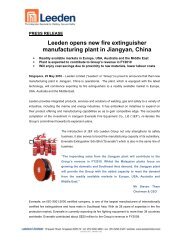Annual Report 2010 - Leeden Limited
Annual Report 2010 - Leeden Limited
Annual Report 2010 - Leeden Limited
You also want an ePaper? Increase the reach of your titles
YUMPU automatically turns print PDFs into web optimized ePapers that Google loves.
A Stronger <strong>Leeden</strong> in Asia.Notes to the Financial Statementsfor the Financial Year ended 31 December <strong>2010</strong>2. Summary of significant accounting policies (cont’d)2.9 Associated companyAn associated company is an entity, not being a subsidiary company or a joint venture, in which the Group has significantinfluence. An associated company is equity accounted for from the date the Group obtains significant influence until thedate the Group ceases to have significant influence over the associated company.The Group’s investments in associated companies are accounted for using the equity method. Under the equity method,the investment in associated company is carried in the balance sheet at cost plus post-acquisition changes in the Group’sshare of net assets of the associated company and is neither amortised nor tested individually for impairment. Goodwillrelating to associated companies is included in the carrying amount of the investment. Any excess of the Group’s share ofthe net fair value of the associated company’s identifiable asset, liabilities and contingent liabilities over the cost of theinvestment is deducted from the carrying amount of the investment and is recognised as income as part of the Group’sshare of results of the associated company in the period in which the investment is acquired.The profit or loss reflects the share of the results of operations of the associates. Where there has been a changerecognised in other comprehensive income by the associates, the Group recognises its share of such changes in othercomprehensive income. Unrealised gains and losses resulting from transactions between the Group and the associate areeliminated to the extent of the interest in the associates.The Group’s share of the profit or loss of its associates is shown on the face of profit or loss after tax and non-controllinginterests in the subsidiaries of associates.When the Group’s share of losses in an associated company equals or exceeds its interest in the associated company, theGroup does not recognise further losses, unless it has incurred obligations or made payments on behalf of the associatedcompany.After application of the equity method, the Group determines whether it is necessary to recognise an additional impairmentloss on the Group’s investment in its associates. The Group determines at each balance sheet date whether there is anyobjective evidence that the investment in the associate is impaired. If this is the case, the Group calculates the amount ofimpairment as the difference between the recoverable amount of the associate and its carrying value and recognises theamount in profit and loss.The financial statements of the associated companies are prepared as of the same reporting date as the Company. Wherenecessary, adjustments are made to bring the accounting policies in line with those of the Group.Upon loss of significant influence over the associate, the Group measures any retained investment at its fair value.Any difference between the carrying amount of the associate upon loss of significant influence and the fair value of theaggregate of the retained investment and proceeds from disposal is recognised in profit or loss.2.10 Joint ventureA joint venture is a contractual arrangement whereby two or more parties undertake an economic activity that is subject tojoint control, where the strategic financial and operating decisions relating to the activity require the unanimous consentof the parties sharing control. The Group recognises its interest in the joint venture using the proportionate consolidationmethod. The Group combines its proportionate share of each of the assets, liabilities, income and expenses of the jointventure with the similar items, line by line, in its consolidated financial statements. The joint venture is proportionatelyconsolidated from the date the Group obtains joint control until the date the Group ceases to have joint control over thejoint venture.Adjustments are made in the Group’s consolidated financial statements to eliminate the Group’s share of intragroupbalances, income and expenses and unrealised gains and losses on transactions between the Group and its jointlycontrolled entity. Losses on transactions are recognised immediately if the loss provides evidence of a reduction in the netrealisable value of current assets or an impairment loss.The financial statements of the joint venture are prepared as of the same reporting date as the Company. Wherenecessary, adjustments are made to bring the accounting policies into line with those of the Group.Upon loss of joint control, the Group measures any retained investment at its fair value. Any difference between thecarrying amount of the former joint venture entity upon loss of joint venture control and the aggregate of the fair value ofthe retained investment and proceeds from disposal is recognised in profit or loss.52





